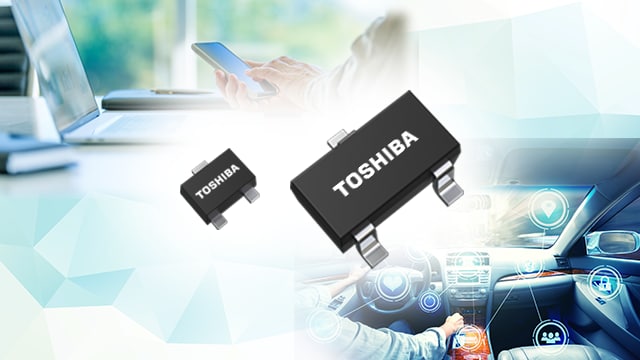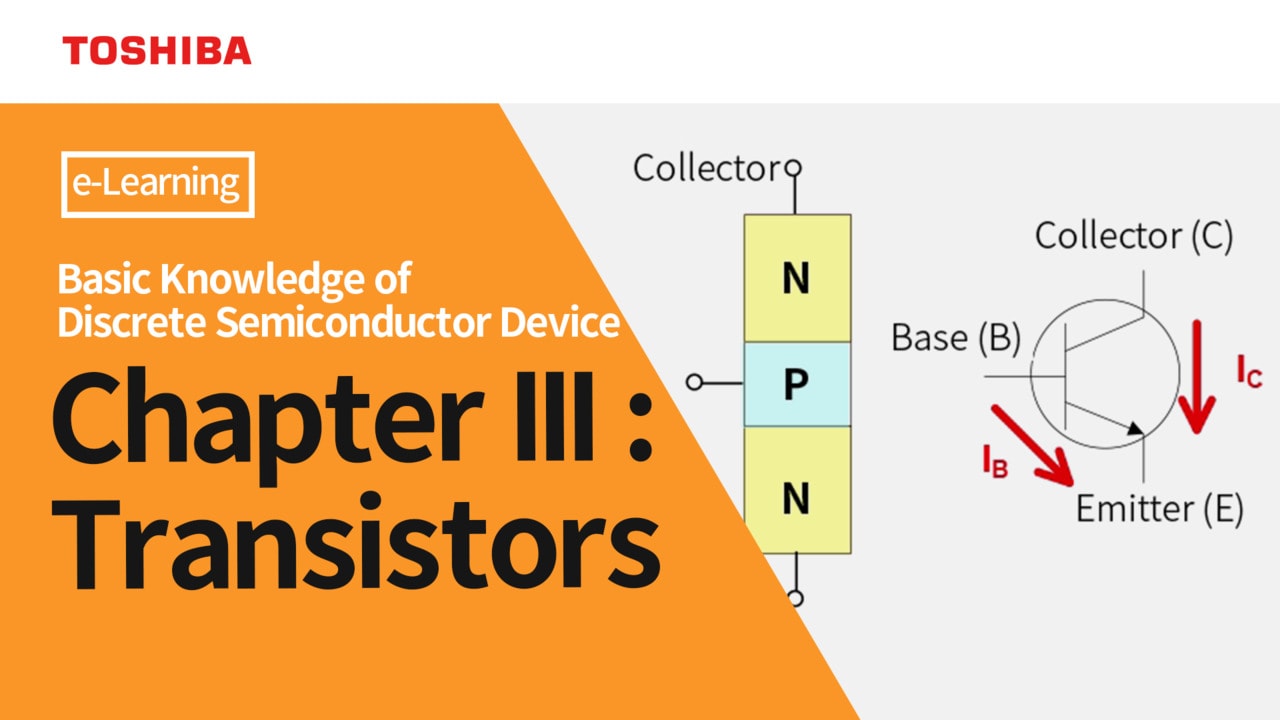- General Top
- SEMICONDUCTOR
- STORAGE
- COMPANY
-
My ToshibaSemicon
- Semiconductor Top
-
ApplicationsAutomotive
Body Electronics
xEV
In-Vehicle Infotainment
Advanced Driver-Assistance Systems (ADAS)
Chassis
IndustrialInfrastructure
BEMS/HEMS
Factory Automation
Commercial Equipment
Consumer/PersonalIoT Equipment
Healthcare
Wearable Device
Mobile
Computer Peripherals
-
ProductsAutomotive Devices
Discrete Semiconductor
Diodes
Transistors
Logic ICs
Analog Devices
Digital Devices
Wireless Devices
※
: Products list (parametric search)
Power SemiconductorsSiC Power Devices
※
: Products list (parametric search)
Isolators/Solid State RelaysPhotocouplers
Digital Isolators
Solid State Relays
Fiber Optic Transmitting Modules
※
: Products list (parametric search)
MOSFETsIGBTs/IEGTsBipolar Transistors※
: Products list (parametric search)
Diodes※
: Products list (parametric search)
MicrocontrollersMotor Driver ICsIntelligent Power ICs※
: Products list (parametric search)
Power Management ICsLinear ICs※
: Products list (parametric search)
General Purpose Logic ICsLinear Image SensorsOther Product ICsOther Product ICs
※
: Products list (parametric search)
-
Design & Development
-
Knowledge
- Where To Buy
- Part Number & Keyword Search
- Cross Reference Search
- Parametric Search
- Stock Check & Purchase
This webpage doesn't work with Internet Explorer. Please use the latest version of Google Chrome, Microsoft Edge, Mozilla Firefox or Safari.
require 3 characters or more. Search for multiple part numbers fromhere.
The information presented in this cross reference is based on TOSHIBA's selection criteria and should be treated as a suggestion only. Please carefully review the latest versions of all relevant information on the TOSHIBA products, including without limitation data sheets and validate all operating parameters of the TOSHIBA products to ensure that the suggested TOSHIBA products are truly compatible with your design and application.Please note that this cross reference is based on TOSHIBA's estimate of compatibility with other manufacturers' products, based on other manufacturers' published data, at the time the data was collected.TOSHIBA is not responsible for any incorrect or incomplete information. Information is subject to change at any time without notice.
require 3 characters or more.
What is the method for measuring the electrical characteristics of bipolar junction transistors (BJTs) ?
An example of a measurement circuit for electrical characteristics (cut-off current, current gain, saturation voltage) described in the data sheet is shown.
Please refer to the FAQ (What are the electrical characteristics of bipolar junction transistors (BJTs) ?) for the explanation of each item.
The electrical characteristics explained here are described in the data sheet as shown in Table. 1.
The measurement method for each item is shown below. Semiconductor characteristics are greatly affected by temperature. It is necessary to consider fluctuations not only due to room temperature but also due to losses (voltage and current) during measurement. In addition to controlling the room temperature at the time of measurement, please consider the time to apply voltage and current. Pulse measurement is recommended to suppress the temperature rise of the transistor.

1. Collector cut-off current ICBO: Fig. 1
It is an electrical characteristic paired with the collector-base voltage VCBO described in Absolute Maximum Ratings. With the emitter open, apply a voltage so that the pn junction between the base and collector is reverse biased, and measure the current. Since the voltage VCB applied between the collector and the base is the absolute maximum rated voltage, care must be taken so that the voltage value does not exceed the specified value. ICBO is the leakage current between the collector and the base, so it fluctuates depending on the temperature.
2. Emitter cut-off current IEBO: Fig. 2
It is an electrical characteristic paired with the collector-base voltage VEBO described in the absolute maximum ratings. With the collector open, apply a voltage so that the pn junction between the base and emitter is reverse biased, and measure the current. Since the voltage VEB applied between the emitter and base is the absolute maximum rated voltage, care must be taken so that the voltage value does not exceed the specified value. IEBO is the leakage current between the emitter and base, so it varies with temperature.

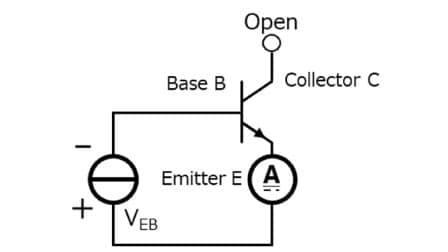

3. DC current gain hFE: Fig. 3
Apply the specified voltage VCE between the collector and emitter and adjust the voltage VBE between the base and emitter so that the target collector current IC is obtained. The base current IB at this time is measured, and the result of the calculation of the following formula is hFE. hFE = IC / IB
Note that hFE is temperature dependent. (Fig. 4)
As shown in Fig. 5, hFE changes due to the Early effect. High frequency transistors with narrow base widths will have a larger change.
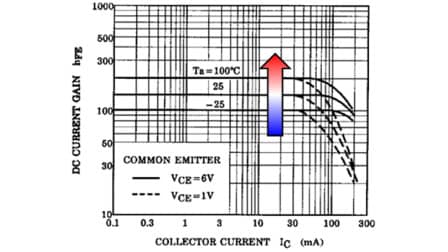
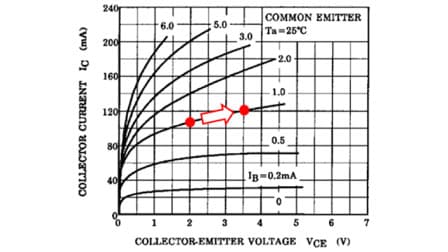
4. Collector-emitter saturation voltage VCE(sat): Fig. 6
In the circuit shown in Fig. 6, first apply a voltage of about 0.6 V between the base and emitter with the voltage source VBE. After that, the collector current IC is applied while gradually increasing until the specified current is reached. Next, change the base voltage VBE until the base current IB reaches the specified value. Measure the collector-emitter voltage VCE when IB reaches the specified current. This voltage is VCE(sat).
If the current source on the collector side is applied while the transistor is off, it may become an abnormally high voltage and destroy the transistor. Set the open-circuit voltage of the current source in advance so that it is less than the collector-emitter voltage VCEO described in the absolute maximum ratings.
VCE(sat) is temperature dependent (Fig. 7).


5. Base-emitter saturation voltage VBE(sat): Fig. 8
First, apply a voltage of about 0.6 V between the base and emitter with the voltage source VBE. After that, the collector current IC is applied while gradually increasing until the specified current is reached. Next, adjust VBE so that the base current IB is the default, and measure the voltage between the base and emitter at this time. This voltage is VBE(sat).
If the current source on the collector side is applied while the transistor is off, it may become an abnormally high voltage and destroy the transistor. Set the voltage when the current source is open so that it is less than the collector-emitter voltage VCEO described in the absolute maximum ratings.
VBE(sat) is temperature dependent (Fig. 9).
This characteristic VBE(sat) is a spec that makes a pair with collector-emitter saturation voltage (Table. 2).
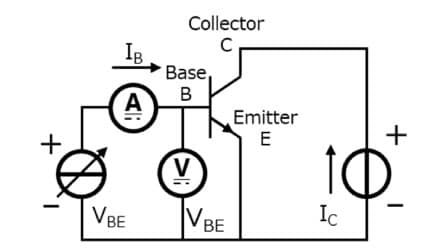
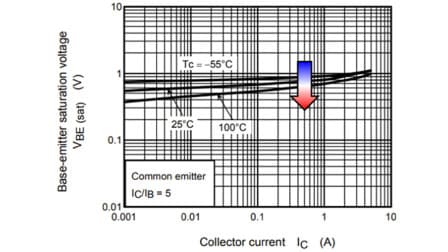

Related Links
The following documents also contain related information:


